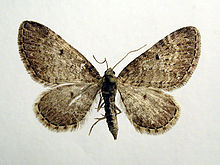bio.wikisort.org - Animal
Eupithecia satyrata, the satyr pug, is a species of moth of the family Geometridae. It was described by Jacob Hübner in 1813. It is found from Ireland, through northern and central Europe (from Scandinavia to the northern Mediterranean) east to all of Russia and central Asia and western Siberia to Tibet. It is also present in North Africa and North America.

The wingspan is 18–24 millimetres (0.71–0.94 in). Eupithecia satyrata is variable in pattern. The ground colour of the wings is ash grey or brownish. The veins often have a black with white dusting. There are paler crosslines. On the forewings a very indistinct terminal fascia ends in a tiny tornal spot. There is a fine discal spot on the forewing. This is absent on the hindwing.[2][3][4] Prout gives an account of the variations.[5]
Adults are on wing from March to September. There is one generation per year.
The larvae feed on the flowers of a wide range of plants, including Achillea, Scabiosa, Solidago, Senecio and Erica tetralix.
Subspecies
- Eupithecia satyrata satyrata
- Eupithecia satyrata callunaria Doubleday, 1850
- Eupithecia satyrata curzoni Gregson, 1884
- Eupithecia satyrata dodata Taylor, 1906
- Eupithecia satyrata intimata Pearsall, 1908
- Eupithecia satyrata juldusi Dietze, 1910
- Eupithecia satyrata rivosulata Dietze, 1875 (Yakutia, Siberia)
- Eupithecia satyrata subatrata Staudinger, 1871
- Eupithecia satyrata zermattensis Wehrli, 1928
Similar species
- Eupithecia intricata
References
- Yu, Dicky Sick Ki. "Eupithecia satyrata (Hubner 1813)". Home of Ichneumonoidea. Taxapad. Archived from the original on March 24, 2016.
- Waring, P. & Townsend, M, 2003, Field Guide to the Moths of Great Britain and Ireland British Wildlife Publishing ISBN 9781472964519
- Skinner, B, 1998, The Colour Identification Guide to Moths of the British Isles , Viking Press, ISBN 9780670879786
- Riley, A.M. & Prior, G., 2003, British and Irish pug moths Harley Books, ISBN 0-946589-51-8
- Prout, L. B. (1912–16). Geometridae. In A. Seitz (ed.) The Macrolepidoptera of the World. The Palaearctic Geometridae, 4. 479 pp. Alfred Kernen, Stuttgart.pdf *
 This article incorporates text from this source, which is in the public domain.
This article incorporates text from this source, which is in the public domain.
External links
- Kimber, Ian. "70.177 BF1828 Satyr Pug Eupithecia satyrata (Hübner, [1813])". UKMoths. Retrieved 10 August 2019.
- Butterflies and Moths of Northern Ireland
- Lepiforum e.V.
Другой контент может иметь иную лицензию. Перед использованием материалов сайта WikiSort.org внимательно изучите правила лицензирования конкретных элементов наполнения сайта.
WikiSort.org - проект по пересортировке и дополнению контента Википедии

